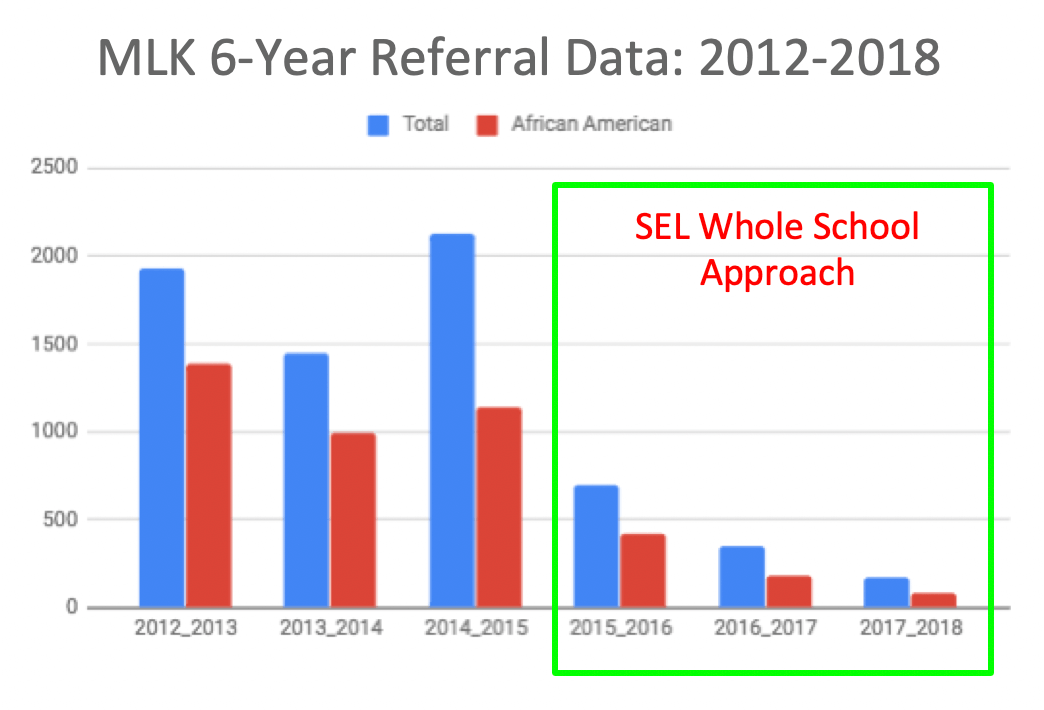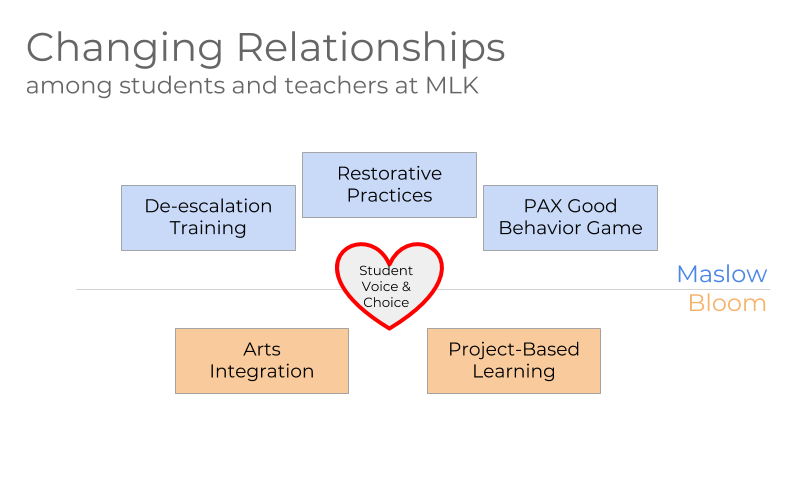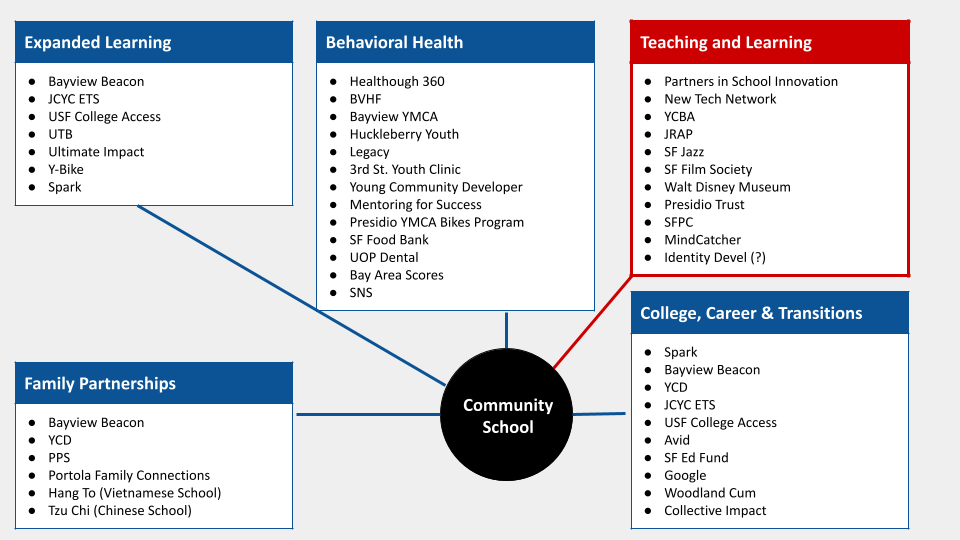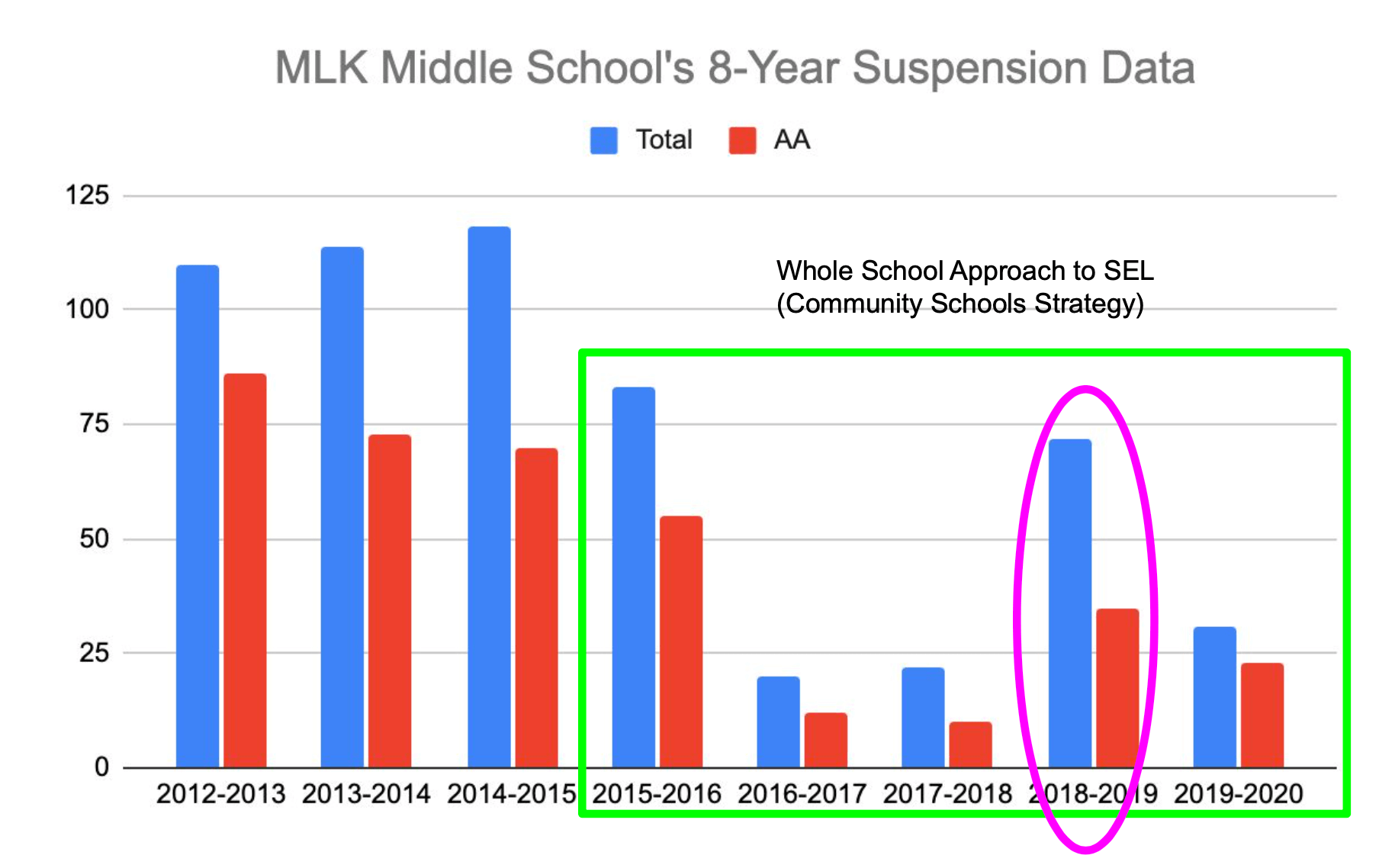How to Turn Around a Middle School

Time for a Good News Story
It's time for a good news story. This one is about a public middle school in San Francisco. Over the past six years, a strong principal and dedicated staff helped a troubled urban middle school move toward success.
When Principal Michael Essien started in 2014 at Martin Luther King, Jr. Academic Alternative Middle School, the school had serious behavior and academic issues. Large numbers of students — particularly African American students — were sent out of class because of inappropriate behavior. (When kids are kicked out of class it's called a referral. Aren't euphemisms great?)
This is a school of about 500 students in grades 6 through 8 where 75.7 percent of students are socio-economically disadvantaged and 26 percent are learning English. It's a very diverse school — rating 59 on the California Diversity Index. About an eighth of the students are African American. About a third are Latino, a third are Asian, 7% are Filipino and the list goes on from there. The school is classically California, so the story of what happened here is valuable.
Below is a “before and after” chart showing what happened to “referrals” over a period of six years.

A close look shows a significant drop starting in 2015-16. In the green box above, the label "SEL" stands for Social-Emotional Learning, which was a focus of the school's response strategy. "Referrals" at the school had been concentrated among the school's African American students (about an eighth of enrollment). Principal Essien concluded that the most effective approach would be to address the underlying issues with changes to lift up the whole school.
What happened?
The school leadership team looked closely at the data — referrals by each teacher — and responded. With support from the school district's experts on behavior, they developed new training for teachers to identify effective approaches to keep students on track and address behavior issues. They developed new opportunities for student engagement. They expanded the curriculum to integrate the arts. And they thought deeply about the relationships between students and teachers, putting student needs at the center of decisions.
 The changes at MLK reflect deep thinking about student needs. They were designed to incorporate the research and thinking of Maslow and Bloom, important thinkers on the subject. Jennifer Hogan, an education commentator who influenced the vision at MLK, argues that to flourish (as described by Bloom), students first need to have their basic needs met (as described by Maslow).
The changes at MLK reflect deep thinking about student needs. They were designed to incorporate the research and thinking of Maslow and Bloom, important thinkers on the subject. Jennifer Hogan, an education commentator who influenced the vision at MLK, argues that to flourish (as described by Bloom), students first need to have their basic needs met (as described by Maslow).
Shifting the Conversation
According to principal Essien, change began with an important question: “What are the adults doing that is producing this behavior in the kids? If we change our behavior, it will change what is happening with the children.”
After reviewing the data, they found that teachers needed help in addressing aggressive behavior caused by trauma. The school made a number of changes:
Teacher training. Teachers received deep instruction on how to handle conflict and how to identify student trigger points. This included de-escalation training. With new skills, teachers are more equipped to understand a child’s behavior escalation pattern and when possible, know how to intervene before things get out of hand. For example:
|
Do |
Don't |
|---|---|
|
Let the person vent |
Don’t take anger personally |
|
Acknowledge the person’s feelings |
Don’t get angry |
Keep kids in class. Teachers don’t send kids out of the classroom. This is a BIG change. Instead, they call an administrator or counselor who comes into the class to help the student get re-focused on the lesson.
Use the PAX game. The school uses the PAX Good Behavior Game to help students make decisions and help teachers reduce bias. Students learn how to work together as a team and how to regulate their own behavior. It helps students pay attention and lets students earn non-material activity incentives for positive behavior in class. The video below shows the game in action.
Student conflict resolution. The school also gives students chances to discuss and solve conflicts and issues. For example, they can create a Powerpoint presentation to explain how to get to better behavior, such as “How not to be tardy.” Some students also participate in a Peer Resources class where they learn how to solve conflicts and help other students through mediation.
Changing Instruction. The school now emphasizes more student engagement and critical thinking in the way it conducts classes. Teachers have added more student projects and more sharing of personal experiences. Teachers ask students to bring their own expertise to their work.
Arts Integration. New arts integration teachers were added to the school staff. They help teachers use the arts to engage students and amplify lessons in core subjects like science, math, social studies and language arts.
Creating a Community School
To further support students and families, the school has redefined itself as a community school in partnership with more than 50 organizations that together bring in about $2.9 million worth of additional services. A district employee works on site assessing school and community needs, coordinating efforts that have dramatically increased the school's capacity to help students and teachers.
|
Before Community Schools |
Current (2015 to present) |
|---|---|
|
Teachers were social workers |
Over 50 Community Partners on site |
|
Different Parts of school working in silos |
Different parts of school working together |
|
9 out of 23 teachers retained |
22 out of 23 teachers retained |
|
30 students receiving support |
Over 380 students receiving additional support (health, academic, mental health) |
Targeted Supports
Five areas were identified where community resources could help the school: teaching and learning to broaden the curriculum, expanded learning through after school programs, family partnerships, behavioral health, and college to career transitions.

Connecting with families during the Pandemic
The Pandemic highlighted the strength of the Community School strategy. When most schools were closed and trying to figure out how to proceed, MLK was able to quickly connect with families to find out their needs. $15,000 was raised and the school provided gift cards to help sturggling families. MLK supplemented the school district’s food distribution to reach more needy families. Cleaning products and first aid supplies were also delivered to families. The work of MLK was so successful that the district mandated all schools to connect with families.
The Results?
Suspensions steadily declined at MLK Middle school, for all students and for African American students in particular. But if you look carefully, you will see a blip in the downward trajectory in 2018-19. That’s an important side story in and of itself — and a testament to the importance of building strong personal relationships with students.

Perhaps because of the patterns of success of MLK, nine struggling students were removed from other middle schools throughout the district and transferred into MLK, mostly into the 8th grade. These students required much more support — and lacking existing relationships with adults or students at the school site, they struggled.
According to Principal Essien, “lack of trust prevented many of the existing school-wide social-emotional strategies at the school site from impacting behavior immediately.” That challenge showed up in both suspension rates and grades.
It pays to look for the blips.
Test scores had been improving dramatically in both math and English language arts, especially for African-American students. But there was a downward blip in the 8th grade in 2018-19, the same year those new students were placed at MLK.
Schools report statistics of various kinds. When you look at the numbers it pays to look for the blips. Community leaders need to be a little like Sherlock Holmes to figure out what's really going on. Somewhere beneath the numbers are real stories of students and teachers struggling to find their way.
Principal Essien speaks with confidence about the direction of his school. "Kids are taking over my school site," he says with a smile. "It is their school."
 |
Learn more about the improvement at MLK Middle School in Carol's interviews with Michael Essien on KALW in 2016 and 2018. |
This post, originally published in 2017, was extensively updated in January, 2021.
Tags on this post
Achievement gap Character Education EquityAll Tags
A-G requirements Absences Accountability Accreditation Achievement gap Administrators After school Algebra API Arts Assessment At-risk students Attendance Beacon links Bilingual education Bonds Brain Brown Act Budgets Bullying Burbank Business Career Carol Dweck Categorical funds Catholic schools Certification CHAMP Change Character Education Chart Charter schools Civics Class size CMOs Collective bargaining College Common core Community schools Contest Continuous Improvement Cost of education Counselors Creativity Crossword CSBA CTA Dashboard Data Dialogue District boundaries Districts Diversity Drawing DREAM Act Dyslexia EACH Early childhood Economic growth EdPrezi EdSource EdTech Education foundations Effort Election English learners Equity ESSA Ethnic studies Ethnic studies Evaluation rubric Expanded Learning Facilities Fake News Federal Federal policy Funding Gifted Graduation rates Grit Health Help Wanted History Home schools Homeless students Homework Hours of opportunity Humanities Independence Day Indignation Infrastructure Initiatives International Jargon Khan Academy Kindergarten LCAP LCFF Leaderboard Leadership Learning Litigation Lobbyists Local control Local funding Local governance Lottery Magnet schools Map Math Media Mental Health Mindfulness Mindset Myth Myths NAEP National comparisons NCLB Nutrition Pandemic Parcel taxes Parent Engagement Parent Leader Guide Parents peanut butter Pedagogy Pensions personalized Philanthropy PISA Planning Policy Politics population Poverty Preschool Prezi Private schools Prize Project-based learning Prop 13 Prop 98 Property taxes PTA Purpose of education puzzle Quality Race Rating Schools Reading Recruiting teachers Reform Religious education Religious schools Research Retaining teachers Rigor School board School choice School Climate School Closures Science Serrano vs Priest Sex Ed Site Map Sleep Social-emotional learning Song Special ed Spending SPSA Standards Strike STRS Student motivation Student voice Success Suicide Summer Superintendent Suspensions Talent Teacher pay Teacher shortage Teachers Technology Technology in education Template Test scores Tests Time in school Time on task Trump Undocumented Unions Universal education Vaccination Values Vaping Video Volunteering Volunteers Vote Vouchers Winners Year in ReviewSharing is caring!
Password Reset
Search all lesson and blog content here.
Login with Email
We will send your Login Link to your email
address. Click on the link and you will be
logged into Ed100. No more passwords to
remember!














Questions & Comments
To comment or reply, please sign in .
Daisy Hartwell February 19, 2021 at 6:01 am
francisco molina February 23, 2019 at 11:56 am